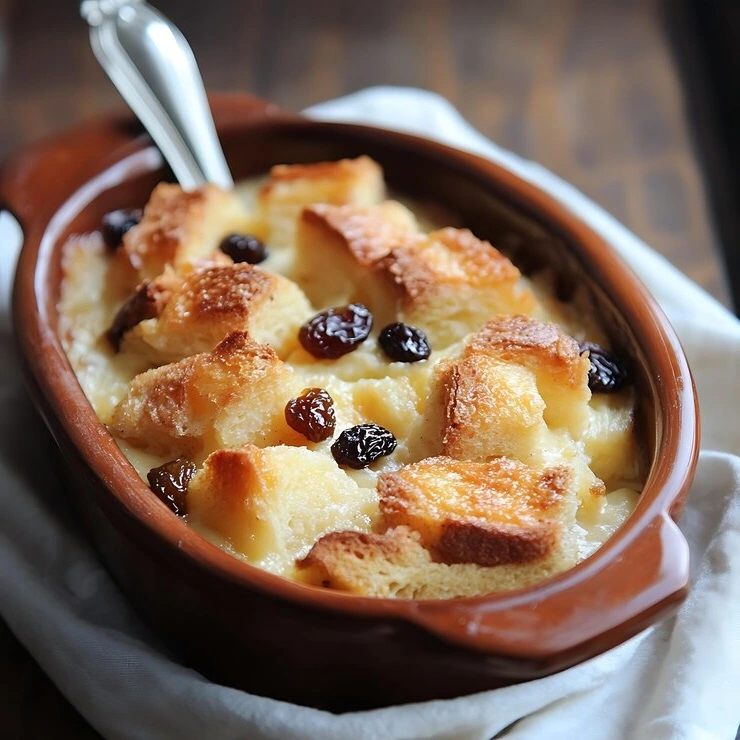the Best Sourdough Bread Pudding: A Comforting Classic with a Tangy Twist

Table of Contents
A Warm Hug in Every Bite
Have you ever opened your fridge to find half a loaf of Sourdough Bread Pudding sitting sadly in the corner, its crust a little too crisp and its texture slightly dry? Don’t toss it. That humble leftover is your golden ticket to a dessert that’s as nostalgic as it is indulgent: sourdough bread pudding.
You know that feeling when the oven warms up your kitchen, and the smell of cinnamon, vanilla, and toasted bread fills the air? That’s the magic of this dish. It isn’t just about turning stale bread into something edible. It’s about crafting a dessert that comforts you, one spoonful at a time. And sourdough, with its subtle tang and chewy bite, gives traditional bread pudding a flavorful upgrade you didn’t know you needed.
Let’s take a closer look at how you can turn your day-old sourdough into a cozy, crowd-pleasing classic.

Why Choose Sourdough for Bread Pudding?
The Tangy Flavor Profile of Sourdough
Unlike soft white bread, sourdough brings a natural depth of flavor to bread pudding. Its tangy notes provide a perfect counterbalance to the sweetness of custard. Instead of being overwhelmed by sugar, your taste buds will appreciate the subtle complexity.
Texture That Holds Up
Sourdough’s firm structure means it can absorb liquid custard without falling apart. You won’t end up with a soggy mess. Instead, expect a golden, crispy top and a soft, custard-soaked center.
Nutritional Benefits
Naturally fermented sourdough is often easier to digest and can be more nutritious than other bread. It’s a small bonus, but it makes indulging feel a bit more justified.
Bonus Tip: If you’re baking sourdough at home, save those crusty ends—they’re perfect for this recipe.
Ingredients for Sourdough Bread Pudding
Here’s everything you need to create your own sourdough bread pudding at home. You likely have most of these in your kitchen already:
Basic Ingredients Table
| Ingredient | Quantity | Notes |
| Sourdough bread | 5-6 cups (cubed) | Preferably a day or two old |
| Whole milk | 2 cups | You can use almond or oat milk too |
| Heavy cream | 1 cup | Adds richness |
| Large eggs | 4 | Room temperature |
| Granulated sugar | 3/4 cup | Adjust to taste |
| Vanilla extract | 1 tablespoon | Adds warmth and aroma |
| Ground cinnamon | 1 teaspoon | Optional: add a pinch of nutmeg |
| Raisins or dried fruits | 1/2 cup | Optional for added texture |
| Melted butter | 2 tablespoons | For greasing your dish |
How to Make Sourdough Bread Pudding (Step-by-Step)
Follow these steps to bring your bread pudding to life:
Step 1: Prep the Bread
- Cut your sourdough loaf into bite-sized cubes.
- If the bread isn’t already dry, spread the cubes on a baking sheet and toast them lightly in the oven at 300°F for about 10 minutes.
Step 2: Mix the Custard
- In a large mixing bowl, whisk together the eggs, milk, cream, sugar, vanilla, and cinnamon.
- Make sure everything is fully blended.
Step 3: Soak the Bread
- Add the bread cubes to the bowl and stir gently to coat every piece.
- Let the mixture sit for 30 minutes so the bread can fully absorb the custard.
Step 4: Bake
- Preheat your oven to 350°F (175°C).
- Butter your baking dish and pour in the bread-custard mixture.
- Bake uncovered for 45–50 minutes. It should be golden on top and slightly wobbly in the center.
Pro Tip: Let it rest for 10 minutes before serving. The flavors meld better and slicing is easier.
Optional Toppings and Variations
Want to take your sourdough bread pudding up a notch? Try these add-ins and toppings:
Sauce Ideas
- Vanilla custard sauce
- Salted caramel drizzle
- Maple bourbon glaze
Mix-Ins
- Semi-sweet chocolate chips
- Chopped walnuts or pecans
- Fresh or dried seasonal fruits like cranberries or apples
Flavor Upgrades
- Add a splash of rum or bourbon to the custard
- Use orange zest for a citrus twist
Storage and Make-Ahead Tips
Storing
- Cover and refrigerate leftovers for up to 4 days.
- Reheat in the oven at 325°F to maintain texture.
Freezing
- Wrap tightly and freeze for up to 2 months.
- Thaw overnight in the fridge before reheating.
Make-Ahead Option
- Assemble the pudding the night before.
- Let it sit in the fridge overnight, then bake fresh in the morning.
Common Mistakes to Avoid
- Using Fresh Bread: It won’t absorb the custard properly and will result in a soggy base.
- Skipping the Soak: A short soak time leads to uneven flavor and texture.
- Overbaking: The pudding should be just set, not dry.
Watch for a golden crust and slight jiggle in the center as your cue to pull it from the oven.

FAQ About Sourdough Bread Pudding
Can I use sourdough with seeds or whole grains?
Yes, but be aware that dense or seeded loaves can change the texture. Stick to lighter sourdough for best results.
Can I make sourdough bread pudding dairy-free?
Absolutely! Swap out milk and cream for almond, oat, or coconut milk. Use plant-based butter alternatives.
What’s the best way to dry out sourdough?
Leave it uncovered overnight or lightly toast the cubes in the oven for 10 minutes at 300°F.
Can I make this in individual portions?
Yes! Use ramekins or muffin tins. Reduce baking time to about 25 minutes.
Final Thoughts: Bring Comfort to Your Table
Sourdough bread pudding isn’t just a clever way to use up leftovers. It’s an invitation to slow down, indulge, and enjoy the process of making something warm and meaningful. Whether you dress it up with sauces and spices or keep it simple and traditional, this recipe will quickly become a staple in your dessert lineup.
So next time you have leftover sourdough, don’t let it go to waste. Turn it into a dish that feeds both body and soul.
Ready to give it a try? Share your twist on sourdough bread pudding in the comments or tag your bake on social media. We’d love to see your creations!
Nutrition Facts
https://www.nutritionix.com/food/bread-pudding



